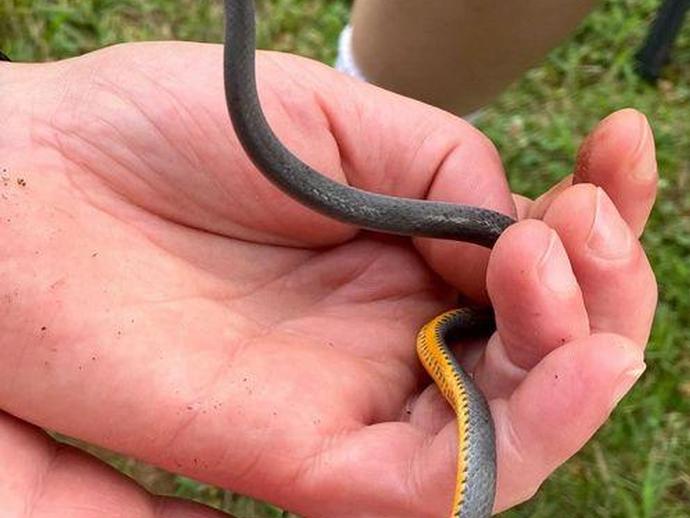August 2, 2021
It's time for another edition of #BenInNature presented by our friends at Carter Bank & Trust!
The ring-necked snake (Diadophis punctatus), seen here being modeled by VMNH Associate Curator of Invertebrate Zoology Dr. Kal Ivanov, is one of my favorite snakes! These little guys are pretty common throughout most of the U.S. and parts of Mexico and Canada, yet you don't see them quite as often as other species. They're rarely seen during the day because they're secretive and mostly nocturnal (just like me; maybe that's why I like 'em so much!).
Ring-necked snakes feed on a wide variety of prey species depending on what's available, including earthworms, slugs, frogs, lizards, and salamanders. Although they're never listed among Virginia's venomous snakes, they are mildly venomous, but they're completely harmless to humans. They have a modified venom gland that allows their mild venom to be channeled down the grooved rear fangs at the back of the mouth. This venom is only used on prey; these snakes are rarely aggressive toward predators and cannot open their mouths wide enough to bite a human. Instead, they flip their tails over into a corkscrew-shape when threatened and show off their brightly-colored undersides to ward off predators.
There are currently 14 recognized subspecies of ring-necked snake, although there's a bit of controversy over some of these. Most of the subspecies are designated based on morphology rather than genetics. Morphology is the study of the forms of things; basically, the subspecies are designated because some ring-necked snakes have different color patterns. Some herpetologists believe that not all of these subspecies are accurate, but instead represent different color variations within the same species. If you're ever eating dinner with a bunch of herpetologists, it's a fun topic to bring up if you want to start a fight!
ABOUT #BenInNature
Social distancing can be difficult, but it presents a great opportunity to become reacquainted with nature. In this series of posts, Administrator of Science Ben Williams ventures outdoors to record a snapshot of the unique sights that can be found in the natural world. New updates are posted Monday - Friday, with previous posts highlighted on the weekends. This series of posts is made possible thanks to the support of VMNH Corporate Partner Carter Bank & Trust (www.cbtcares.com).
NATURE PHOTO IDENTIFICATIONS
If you discover something in nature that you would like help identifying, be sure to message us right here on Facebook with a picture (please include location and date of picture) and we'll have our experts help you identify it!

 Hours & Admissions
Hours & Admissions Directions
Directions

